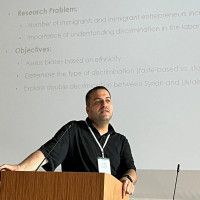Articles
Issue Editorial Board



 0000-0002-1196-998X
0000-0002-1196-998X

 0000-0003-0053-6043
0000-0003-0053-6043



 0009-0007-8880-6947
0009-0007-8880-6947
Aim & Scope
The main purpose of Journal of Human and Work is to share with readers the studies that have been conducted by establishing a connection between the theories and practices put forward in the field of organizational behavior and human resources management in order to understand human behavior in business life and to benefit from human resources at the highest level.
Journal of Human and Work aims to publish empirical or theoretical studies in all areas of organizational behavior and human resources management where business and human are concerned. The journal includes studies on every subject in the field of organizational behavior and human resources management at the individual, group and organization level.
As an example of the topics covered by the journal, the topics are mentioned below according to levels.;
• Individual level; personality, perception, attitudes, values, motivation, stress, emotions, and committment
• Group level; group structure and size, leadership, power, influence, and political behavior
• Organization level; issues such as change management and human resources and applications
• Across levels; performance, job satisfaction, absenteeism, employment, workforce diversity, career, work-life balance, and topics such as organizational culture and climate.
Author Guidelines
Manuscript Preparation
File Format: All files should be submitted as a Word document.
Manuscript Language: Manuscript should be either in English or Turkish language. For manuscript in English language, spelling should follow one of American or British conventions and must be consistent throughout the text.
Manuscript Length: Manuscript should be between 4000 and 7500 words in length.
General Rules for Text: The journal uses the most recent APA (American Psychological Association) guidelines. All papers should be double-spaced throughout, (including the reference section) with one inch margins all around. Do not add extra lines between paragraphs or sections. The font should be 12 pt and be a "serif" type style, such as Times or Courier. All paragraphs should be indented half an inch, not five spaces. Only one space should be added between the period at the end of a sentence and the first letter of the next.
Parts of the Manuscript: Manuscripts should be presented in the following order: title page, abstract and keywords, text, acknowledgements, references, tables, figures, and footnotes.
Title page: The title page should contain (i) the title of the paper, (ii) the full names of the authors, (iii) the authors’ affiliation which identifies the location of the author(s) at the time the research was conducted, which is usually an institution, and (iv) the full postal and email address, plus facsimile and telephone numbers, of the author to whom correspondence about the manuscript should be sent. The title should be short and informative, and be no longer than 12 words long.
Abstract and key words: All manuscripts must have a brief abstract that states in 150 words. The abstract should state briefly the purpose of the research, the methods employed, the principal results, and major conclusions. The abstract should not contain abbreviations or references. Five key words should be supplied below the abstract in alphabetical order.
Text: The text should be organized into an introductory section, conveying the background and purpose of the research, and then into sections identified with subheadings.
Acknowledgements: The source of financial grants and other funding must be acknowledged. The contribution of colleagues or institutions should also be acknowledged.
References: The reference list should include only and all of the sources the author actually cited in the text. The reference list should start on a new page and should have the word “References” centered at the top of the page. The items on reference list should be arranged alphabetically by the author's last name, letter by letter, interfiling books, and articles. More than one reference from the same author(s) in the same year must be identified by the letters "a", "b", "c", etc., placed after the year of publication. All references must be double spaced. An extra line should not be added between references, "hanging indents" should be used, meaning that the first line of each reference goes all the way to the left margin, with the following lines of each reference indented. Each reference cited in the text must appear in the reference list, and each entry in the reference list must be cited in the text.
Text citations consist of the author’s name (or the title of the work if no author is indicated), the date of publication, and page citation (if appropriate): (Smith, 1999). Multiple references should be shown in alphabetical order.
For one or two authors, cite the names every time the reference occurs: Smith and Jones (2001) or (Smith & Jones, 2001).
For more three to five authors, cite all authors in the first instance, thereafter, only first author followed by "et al." and the year of publication: Campbell, Brady, Bradley, and Smithson (1991) found ... (first citation) ……….. Campbell et al. (1991) found ... (subsequent citations).
For with six or more authors, cite only the first author followed by "et al." and the year. In the list of references give all names up to and including six authors.
Reference examples:
Book: McGregor, D. M. (1960). The human side of enterprise. New York, NY: McGraw-Hill.
Article in an edited book: Ang, S. & Van Dyne, L. (2008). Conceptualization of cultural intelligence: Definition, distinctiveness, and nomological network. In S. Ang, & L. Van Dyne, (Eds.). Handbook of cultural intelligence: Theory, measurement, and applications (pp. 3-15). Armonk, NY: M.E. Sharpe.
Journal article: Van Rooy, D., & Viswesvaran, C. (2004). Emotional intelligence: A meta-analytic investigation of predictive validity and nomological net. Journal of Vocational Behavior, 65(1), 71-95.
Unpublished dissertation or thesis: Author, A. A. (2005). Title of doctoral dissertation or masters thesis (Unpublished doctoral dissertation or master's thesis). Name of Institution, Location.
Paper (or poster) presentation: Presenter, A. A. (Year, Month). Title of paper or poster. Paper or poster session presented at the meeting of Organization Name, Location.
Technical or Research Report: Author, A. A. (Year). Title of work (Report No. ???). Location:Publisher.
Entire Book, Electronic Version: Author, A. A. (Year). Title of work. Doi:???, or Author, A. A. (Year). Title of work. Retrived from http://www.????
Online Blog, Video, and Message Postings: Author, a. A. (Year, month, Day). Title of post [Description of form]. Retrieved from htttp://www.????
Tables and Figures: Type tables and figures on a separate page with the legend above. All tables should be supplied on separate sheets, not included within the text. Please identify where in the text the table should appear by noting “Table 1 approx here”; there should also be a mention of the table in the text (e.g.: see Table 1). Figures should be supplied as high quality, and original artwork. Figures should be cited in consecutive order in the text (e.g.: see Figure 1).
Footnotes: Footnotes should not be used for citing references. Footnotes should be placed as a list at the end of the paper only, not at the foot of each page. Keep footnotes brief: they should contain only short comments tangential to the main argument of the paper.
At the end of the text of the article and before the references; "funding", "author contribution statement", "conflict of interest", "ethical approval", "informed consent form" information should be written. For example;
Funding: This study has not received support from any organization such as public, commercial or non-profit organizations.
Author Contribution Statement: 1. Author's contribution rate is %..., 2. Author's contribution rate is %..
Conflict of Interest: On behalf of all authors, the responsible author declares that there is no conflict of interest.
Ethics Approval: All procedures performed in studies involving human participants are in accordance with the ethical standards of the institutional and / or national research committee and the 1964 Helsinki declaration and its later amendments or comparable ethical standards. Ethics Committee Approval was obtained for this research from the Human Research Ethics Committee of the University of ……… with the decision number ... dated ... .
Informed Consent Form: Informed consent forms were obtained from all individual participants who participated in the study.
Plagiarism (similarity) warning: Journal of Human and Work receives a similarity report via intihal.net. When the full text file is uploaded in the 3rd step of the article upload phase, it will be forwarded to intihal.net. The preparation of the report may take time. Therefore, an e-mail will be sent to you when the process is completed. In the last step, you can complete the submission according to the final report or repeat the process by returning to step 3. When you upload more than one file and receive a similarity report, all reports will be forwarded to the editor. A maximum of 25% similarity rate is allowed in the study and a maximum of 3% from a source. Studies that do not meet the desired value ranges are rejected. If the article is produced from a thesis, it should be stated that it was produced from the thesis with a footnote given to the article title. The similarity rate cannot exceed 25% in articles produced from the thesis.
All articles sent to the journal should be prepared according to the sample article template. This word template is the full format of the journal. After converting your article to this format, upload it to the system.
Ethical Principles and Publication Policy
Ethical Principles and Publication Policy
Information on Ethics Committee Permissions
Articles submitted to Journal of Human and Work are expected to be prepared in accordance with scientific research and publication ethics.
Research requiring ethics committee permission;
* Any research conducted with qualitative or quantitative approaches that require data collection from participants using survey, interview, focus group study, observation, experiment, interview techniques,
* Use of humans and animals (including material/data) for experimental or other scientific purposes, Clinical research conducted on humans,
* Research conducted on animals,
* Retrospective studies in accordance with the law on the protection of personal data.
In addition;
* In case reports (case analysis), it must be stated that an “Informed Consent Form” was obtained, Permission must be obtained and stated from the owners for the use of scales, surveys, photographs belonging to others,
* It must be stated that copyright regulations are complied with for the intellectual and artistic works used.
The status of the manuscript submitted to the journal regarding ethical issues and ethics committee permissions must be clearly stated in the "Ethical Approval" and "Informed Consent Form" sections at the end of the relevant article (please see the writing rules).
In the absence of these permissions and if the manuscript is not submitted to the journal at the submission, the article is returned to the author at the preliminary review stage.
Ethical Principles and Publication Policy
Journal of Human and Work does not charge an article processing fee or a subscription fee for access to manuscripts at any stage of the publication process.
Publication Ethics
Journal of Human and Work adopts the ethical standards determined by the Committee on Publication Ethics (COPE). COPE makes recommendations to editors and publishers on publication ethics, and particularly indicates how to behave and what to do regarding research and publication misconduct.
Editor's Responsibility
Editors evaluate incoming manuscripts in terms of scientific content without taking into consideration the ethnic origin, gender, sexual preference, nationality, religious belief or political philosophy of the authors. They provide a fair double-blind peer-review process for the publication of submitted manuscripts. They ensure that all information about the submitted manuscript is kept confidential until publication. Editors are responsible for the content and overall quality of the publication. They publish corrections when necessary through editorial notes. Editors should not allow any conflict of interest or competition between authors, editors and referees. Only the Editor has full authority in the appointment of referees in Journal of Human and Work and is responsible for the final decision regarding the publication of the articles.
Referees' Responsibilities
Referees evaluate the submitted manuscripts in terms of scientific content without considering the ethnic origin, gender, nationality, religious belief or political philosophy of the authors. There should be no conflict of interest or competition regarding the research, authors or sponsors for the referees. Referee decisions should be objective. Referees should indicate relevant published publications that have not been cited by the author. They are obliged to keep all information regarding the submitted manuscript confidential and to notify the Editor when they become aware of any copyright infringement or plagiarism committed by the author. When the referee thinks that the content of a submitted article is incompatible with their own scientific field or knowledge or in cases where they cannot make a rapid evaluation, they must inform the Editor and ask for their forgiveness from the evaluation process.
Authors' Responsibility
Authors must guarantee the originality of the manuscripts they submit. They must declare that the manuscript has not been published anywhere else, in any language, or has not been evaluated for publication. They must comply with the applicable copyright agreements and laws. Copyrighted material such as tables, figures or other contributing citations in our journal are published only with valid permission and copyright approval, and this responsibility belongs to the authors. Authors must appropriately cite other authors, contributors or sources and indicate the relevant sources.
Plagiarism Policy
The journal has a zero-tolerance policy regarding plagiarism.
The editor handles plagiarism in two ways: peer review and plagiarism prevention software (e.g. intihal.net). All submissions to the journal are checked with a software called intihal.net before they are sent for peer review. If plagiarism is detected by either the referees or the editorial office at any stage of the submission - before or after acceptance, at any stage before publication - the editor may notify the author(s) and request that the submission be rewritten and/or properly cited. If plagiarism is very widespread (e.g. more than 25% of the submission is plagiarized), the submission may be rejected or the author(s)'s institutions may be notified of the violation.
Price Policy
Dergideki tüm süreçler ücretsizdir.

İş ve İnsan Dergisi (e-ISSN 2148-967X) Creative Commons Alıntı-LisansDevam 4.0 Uluslararası Lisansı ile lisanslanmıştır.

